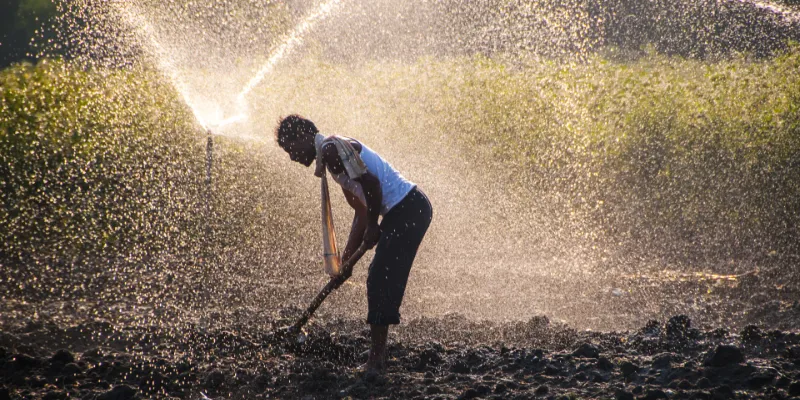Three lessons that India can learn from Telangana's historic Kaleshwaram Project
About 40 percent of India's population will have no access to drinking water by 2030, says NITI Aayog. Amid this, Telangana is in the news for the world's largest lift irrigation project - Kaleshwaram. What can we learn from it?
Anandha Reddy is a farmer from Bayyaram Village, Siddipet District, Telangana. He has about four acres of thirsty land, which has twelve boreholes. He was ‘lucky’ as the twelfth borehole finally showed signs of water, at more than 1,000 feet. But, his expenditure of Rs 18 lakh on water discovery is a risky journey as he took hand loans from everyone, including money lenders. There is no way his agricultural output will earn him enough money to repay these loans.
The day is not far when he would sell a part of the land to make the loan repayments. This is a very familiar story in the state of Telangana, which is in the news for its historic ‘Kaleshwaram Project’ (the project) - the world’s largest lift irrigation project. Our interaction with smallholder farmers across 100 villages in the coverage area of this project made me see the aspirations and emotions of the farmers from close quarters.

What can the rest of India learn from this project?
Lesson 1: Thirst of the cities can be quenched
India is running out of water - fast. About 40 percent of India's population - including 21 cities - will have no access to drinking water by 2030, according to a report by think tank NITI Aayog. The project is expected to feed the thirst of Hyderabad, with 30 tmc ft of the 200 tmc ft water of the project allocated to it.
This approach is the only ray of hope for Hyderabad, one of the fastest growing cities in the country, to stay out of the list given by NITI Aayog. Other cities should find a way to implement such solutions in the next five years time before it’s too late.

A rain barrel is a traditional yet effective method to conserve water. (Image: Shutterstock)
Lesson 2: Source of funding decides the ease of problem-solving
Polavaram is a prestigious irrigation project in the state of Andhra Pradesh. Till date, the state government has not found a reliable financier for the project. Work on rehabilitation has stopped due to funds crunch. Its budget increased from Rs 10,800 crores in 2004 to Rs 58,000 today.
In comparison, Polavaram covers a third of the area covered by Kaleshwaram, at a budget that is almost 60 percent of Kaleshwaram.
Most importantly, Polavaram is far from completion, while Kaleshwaram is inaugurated. The main reason for the completion of Kaleshwaram is that it is fully state-funded, while the Polavaram project is running around for funds from the centre and other international agencies.
Increased dependency on multiple external agencies for funding critical projects can complicate the timelines and result in cost escalations.
Lesson 3: Politicians need to imbibe and promote project management expertise
Inspiring leadership and statesmanship are necessary for historic projects like this to see the light of the day.
Kalvakuntla Chandrashekhar Rao showed his intent to solve the water crisis by resolving the old tussles with the government of Maharashtra and his erstwhile irrigation minister Harish Rao was phenomenal with rigorous project management.
This is often something that goes missing with government projects. This ensured that a critical mass of the project got completed in three years time. Politicians should not confine their job to making political promises but should build the skill to stay committed to delivering them with sincere intent.
What else should the Telangana government remember to promote?
The project is expected to provide irrigation to about 50 lakh acres, including command area. This is extraordinary. Hopefully, about 20 to 25 lakh farmer families will be getting water. This is more than a dream come true for the farmers. But, this will generate the desired benefits on a lasting basis only when such farmers are trained on judicious usage of water.
Great nations are not built without failures. The same Telangana Rashtra Samithi Government announced 24 hours free power supply to the farmers with a good intention that the farmers should never struggle for water.
This, coupled with scanty rainfall, resulted in the borewells drying up due to overutilisation. The same farmers who were once appreciative of such 24-hour power supply regret not knowing the consequences of the exploitation of water.
A project like Kaleshwaram can happen only once in the history of farmers of Telangana. For it to be the lifeline of farming, the state's government should act on promoting techniques like greenhouse farming for smallholder farmers, micro-irrigation and other climate-smart farming techniques to ensure that water is respected as a valuable resource, than being considered a free resource.
Having water metres and training farmers on economical usage of water will be critical in ensuring that the farmers like Anandha Reddy can have lasting happiness. After all, we know how much money and effort is going into getting this life-changing resource into the lives of farmers.









